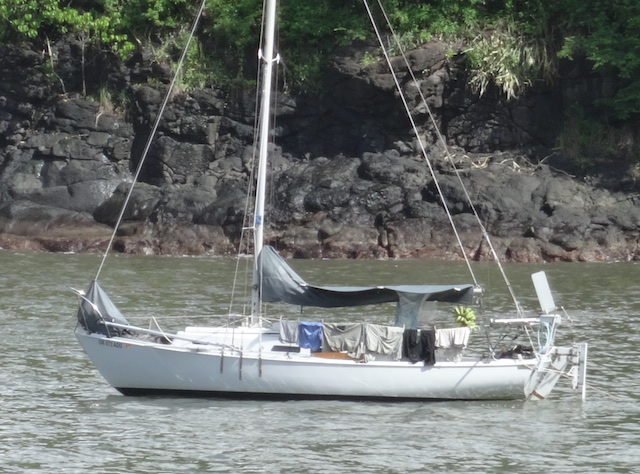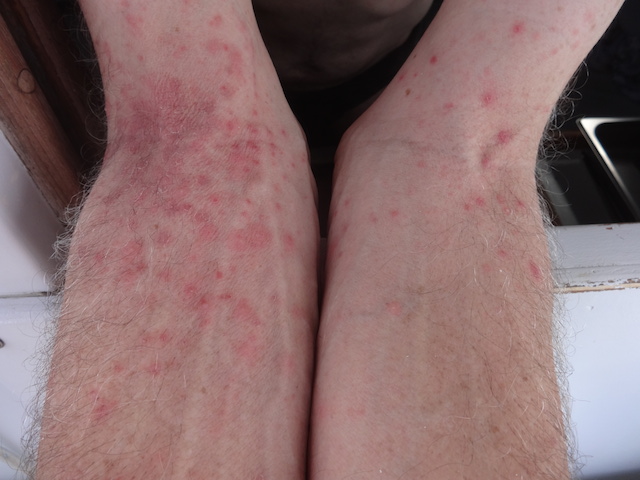We've been asked a
number of questions that we'll try to answer here.
--Are tsunamis a
danger here?
They're unusual here, but certainly a threat when they
happen, even when generated from as far away as Chile. If it happens,
everyone leaves the anchorage as quickly as possible. Once out in
deep water, they're no longer a danger.
--What was the
physical feeling of being back on land?
From the instant we set foot
onshore, the sensation was that the land was swaying back and forth.
The feeling lasted for 4-5 hours. Even after several days, we still
feel it when we go ashore, though each day it takes less time to get
over it.
Emotionally, we were
so preoccupied with getting the inflatable kayak ashore at the
somewhat challenging landing and then dealing with the land swaying,
that it was some minutes before we stopped, realized that we were
indeed on land again and had a long embrace of gratitude.
Pearl says that what
surprises her is how much she misses the voyage for the simplicity of
the day to day routine. While we sometimes had to make decisions and
carry out tasks at all hours of the day and night, there was also a
lack of the sort of stress we often feel ashore. Pearl's take is that
life on land is far more complicated with a much wider range of
decisions and tasks than at sea.
After 6 weeks at
sea, where there was relatively little physical exertion other than
hanging on and balancing, we found almost every activity on land
exhausting. By the end of the first day, even though we wanted to
send a text message, neither of us had the gumption to do it.
Our legs were sore
when we woke up the next morning, but interestingly, no where near as
sore as after I sailed to Hawaii. I think the difference is that
that voyage was on a catamaran in which everything was on the same
level. Moving around on Minimus requires going up two steps from the
cabin to the cockpit, which we would do many times a day. The
frequent up and down was no doubt more exercise.
--What was it like
to eat our first dinner and take our first shower?
Our first real
dinner was here on Minimus. Pearl prepared salted cucumber slices
followed by eggplant parmesan with french cheese melted on top and
baguettes, and bananas for dessert. It was the first fresh food we'd
had in many weeks and was heavenly.
Our first shower was
also heavenly, though an unusual experience. Onshore beside the bay
is a concrete block privacy structure about 4-1/2 feet high with a
pipe overhead. It offers privacy from the chest down, but otherwise
is in full view of everyone in the area. The water is cold only,
which is welcome in this climate. It felt great to wash off 6 weeks
of salt water!
--How did this
landfall compare with Davids Hawaii landfall in 1980?
I (David) had never
sailed offshore before the Hawaii voyage, so felt quite a bit of
apprehension on that trip. Much of it was not knowing what to
expect, feeling of course quite exposed to whatever weather developed
along the way and wondering if the boat was really up to the trip.
As it turned out, the boat was quite up to the trip. (I discovered
afterward that according to people in the know, it was at the time
the first ocean crossing ever done in a catamaran that small,
something I was glad I didn't know then.) In addition, I had no
communications of any kind on that trip and thus no weather
forecasts, emergency calling capability or human contact of any kind.
Nor did I have any check on whether my navigation was on track.
In contrast, just
about all of those factors were different on this voyage. We had
satellite communication, emergency calling capability, pinpoint GPS
navigation, and, above all else, I not only had a companion this
time, but the perfect companion.
One would think I
wouldn't have felt any apprehension this time. Alas, that was not
the case. I may seem like an inveterate adventurer, but the fact is,
I'm a worrier at heart. Perhaps that's why I've survived some of my
adventures. I'm always thinking about the weak links, about what
might go wrong and about how to respond if they do.
The list is long.
What if we hit a floating container or a sleeping whale at night? The
boat is strongly built, but if holed, her 1700 lbs of lead ballast
would sink her like a stone. What if lightning strikes the mast and
melts the lanyards, causing the mast to fall? That slight looseness
in the rudder, does it portend something serious there? And so forth,
ad nauseum.
I've concluded
there's no hope for it, it's just my nature. It's also part of why
we make such a good team on these adventures. I'm always
anticipating the worst and trying to prepare for it so it doesn't
actually happen, while Pearl realizes how unlikely it is to happen in
the first place and just chills without getting wrapped around the
axle. My preparations help to insure that her perspective is what
actually happens and her perspective helps me to enjoy the experience
instead of focusing on what might go wrong.
Certainly part of my
apprehension on this voyage was related to a sense of responsibility
for her. I don't mean that to sound like she was a burden. Nothing
could be further from fact. It's just that if it were not for me she
wouldn't have done the voyage, so there was no escaping a certain
sense of responsibility.






















































